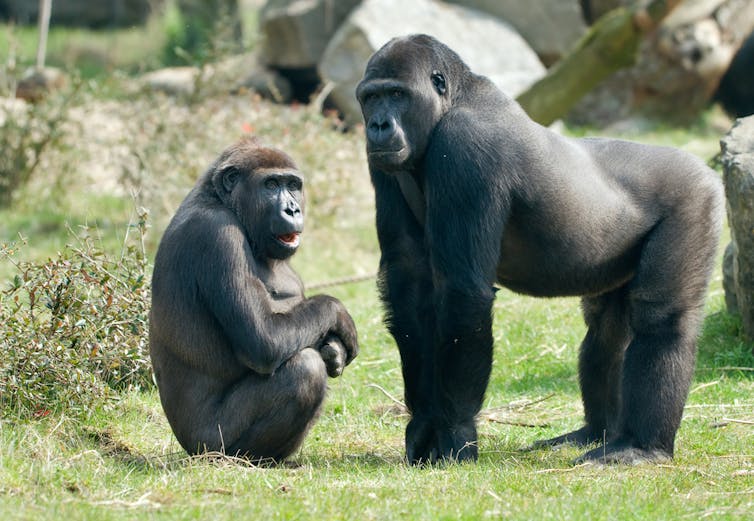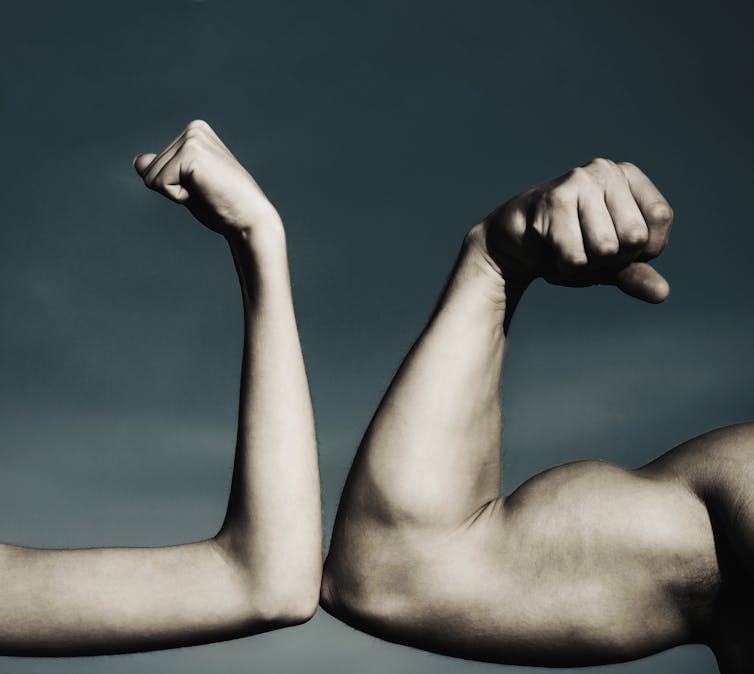Women show sexual preference for tall, dominant men – so is gender inequality inevitable?
Women show sexual preference for tall, dominant men – so is gender inequality inevitable?

The old cliché tells us the most desirable men are “tall, dark, and handsome” – and scientific research confirms that heterosexual women tend to prefer partners who are taller than them.
One study found that, on average, women’s satisfaction with their partner’s actual height was greatest when he was 21cm taller than themselves. Conversely, men’s satisfaction was greatest with a woman who was 8cm shorter than them. Not only do women want taller men; they seem to favour a bigger height difference than men.
Women’s choice of taller men might indicate a preference for men who are more dominant, which may be due to the way that biological evolution has shaped our brains. This in turn may have shaped our culture, and the norms that reinforce the expectation that a man should be taller than his female partner.
Fortunately, we can change our culture.
The animal ‘kingdom’

Sexual dimorphism – where one sex is substantially larger or otherwise different in appearance to the other – is common among animals.
In some species – such as spiders, including the Australian red back – the female is larger than the male.
But in mammals, including us humans, it is often the male who is larger.
Among our closest living relatives – the chimpanzee, gorilla and orangutan – males are bigger than females. They are physically stronger, and have larger, sharper canine teeth.
While such characteristics benefit males in competition with one another, they also enable them to physically and sexually dominate females.

Women’s preference for dominant men
Besides the preference for height, women also tend to show a preference for indicators of dominance in men, such as physical strength and masculine facial features. The controversial psychologist Jordan Peterson goes as far as claiming that women hate harmless men.
Large, dominant men can offer greater protection to their partners and children from other men, and were likely to have been better providers of food and other resources throughout our evolutionary history. This suggests that it is adaptive, in evolutionary terms, for women to be attracted to such men and to choose them as partners.
Research supporting this argument has found that women with a higher fear of crime are more likely to prefer physically formidable and dominant males. In addition, women who score lower on dominance show a stronger preference for taller men.
Unfortunately, the preference for larger and more dominant men comes with a cost. Such men, while they might protect their partners from other men, also present the risk of turning their aggression onto their partners.
By choosing larger and more dominant men, women potentially become more vulnerable to physical and sexual domination by their partner. Crime statistics show that the majority of intimate partner murder victims are female.
Does our biology make us inherently sexist?
Evolution by natural selection has no predetermined purpose, and doesn’t work towards any goal. It simply describes how physical and psychological characteristics become more common if they help an organism pass on its genes.
The desire in females for tall, dominant males is just likely to have been a successful way of propagating genes, even before Homo sapiens evolved.
Although we are not blind to the benefits of size, these sexual and romantic preferences are not determined by conscious choice, nor are they always rational or desirable. We don’t choose what we find attractive, much like all other animals whose brains are also the products of evolution.
So the fact that women prefer male partners who can – and often do – dominate them does not mean that women want to be dominated. The genetic payoff over evolutionary time for producing offspring with such men has simply been greater than any genetic costs of being dominated by them. Women risk aggression from their partners as part of a strategy to counteract the threat of violence from other men.

Growing up
While our biologically based preferences are largely outside our conscious control, they do not rigidly determine our behaviour or render us incapable of acting otherwise. We can resist our impulses and urges, and make reasoned choices about how we behave.
Our biology shapes our culture, and culture does its part to reinforce our biology. Even in the modern world we continue to perpetuate cultural norms that place value on greater height and dominance in men, and on slightness and submission in women.
But this is not “just culture”, as many might argue. Females’ near-universal preference for large, dominant males suggests that culture is a co-conspirator, rather than the cause, of this process.
And culture is not fixed – as shown by the progress that society has already made towards gender equality. We can challenge the cultural norms that undermine those who don’t adhere to the status quo. We can foster values that purposefully compensate for the flaws in our nature. This might lead to a more equal society, where women won’t even feel they need protecting.
But we need to critically examine our minds to understand ourselves and gain the power to escape our biology’s grip on us. Perhaps then, the things that aren’t necessarily good for us will cease to be so seductive.![]()
Beatrice Alba, Research Fellow, Australian Research Centre in Sex, Health and Society, La Trobe University
This article is republished from The Conversation under a Creative Commons license. Read the original article.